
|
On Drawing and Contouring With Different Types of Lines in Your Artwork
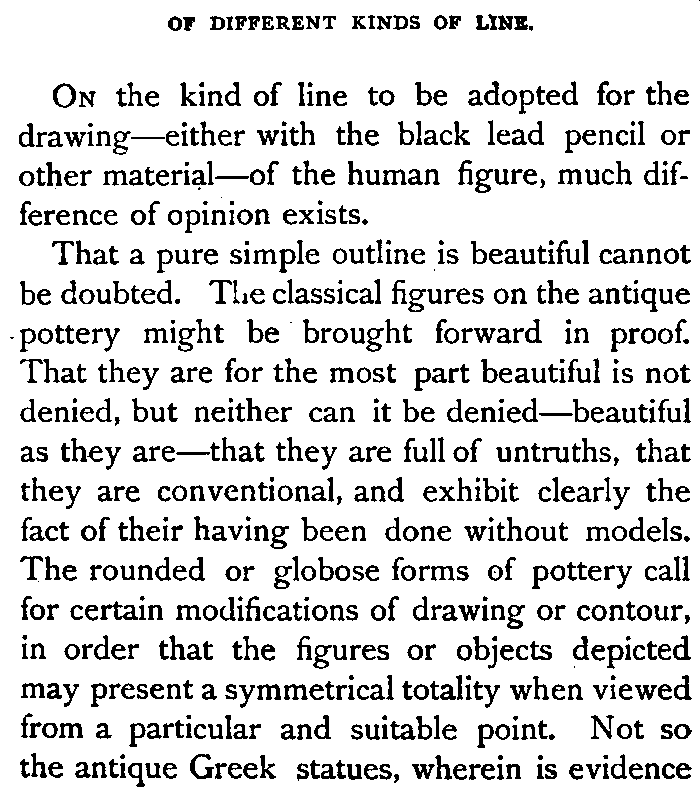
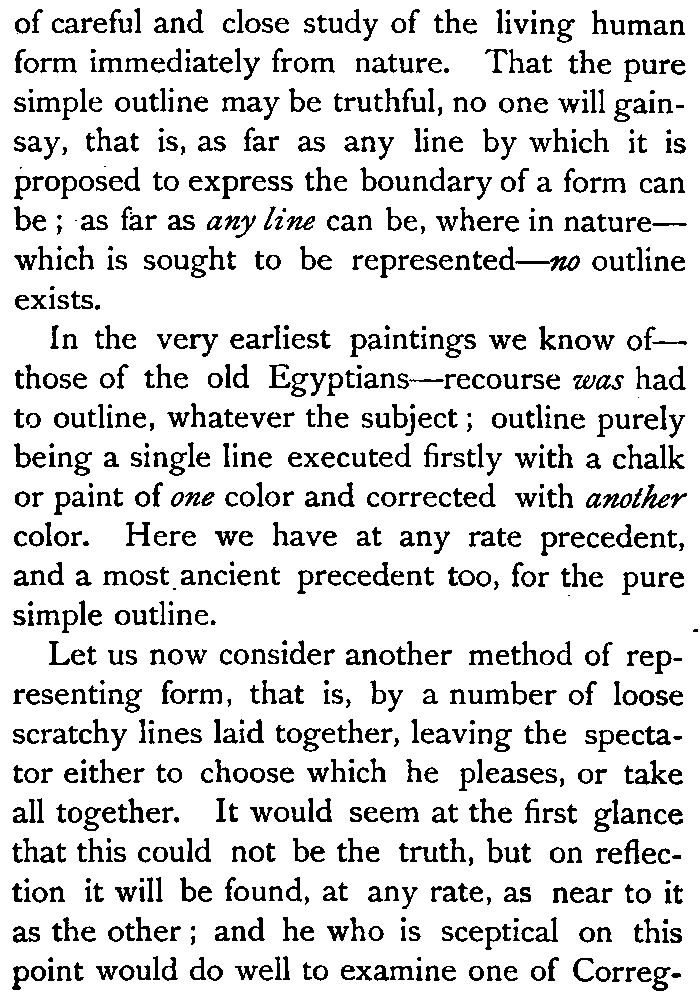
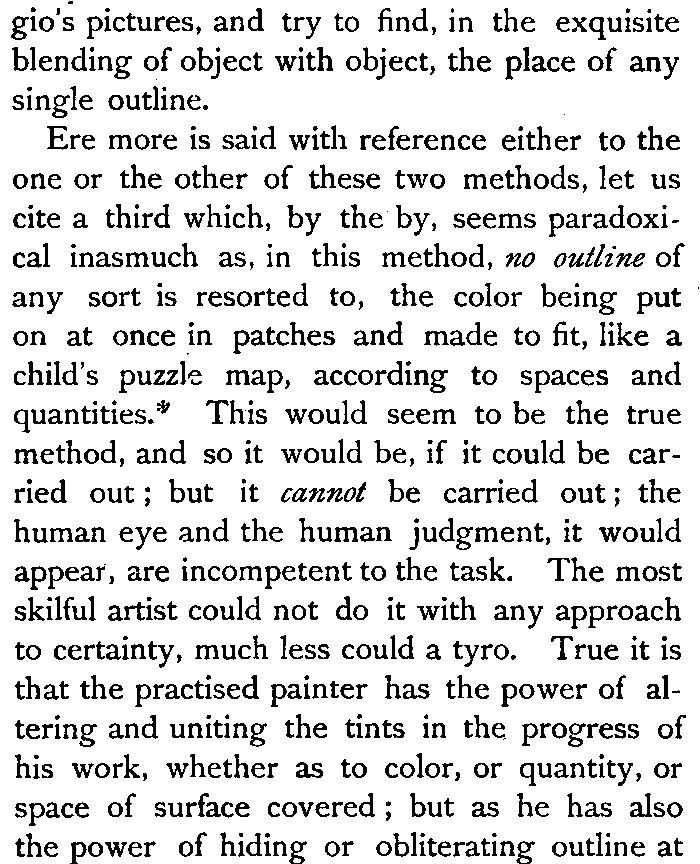
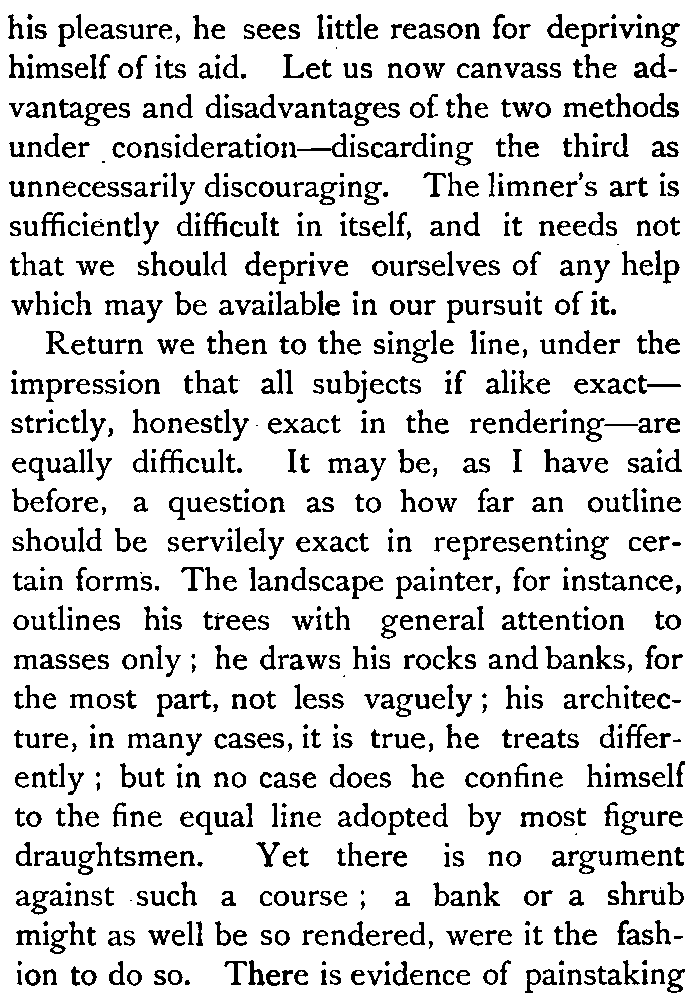
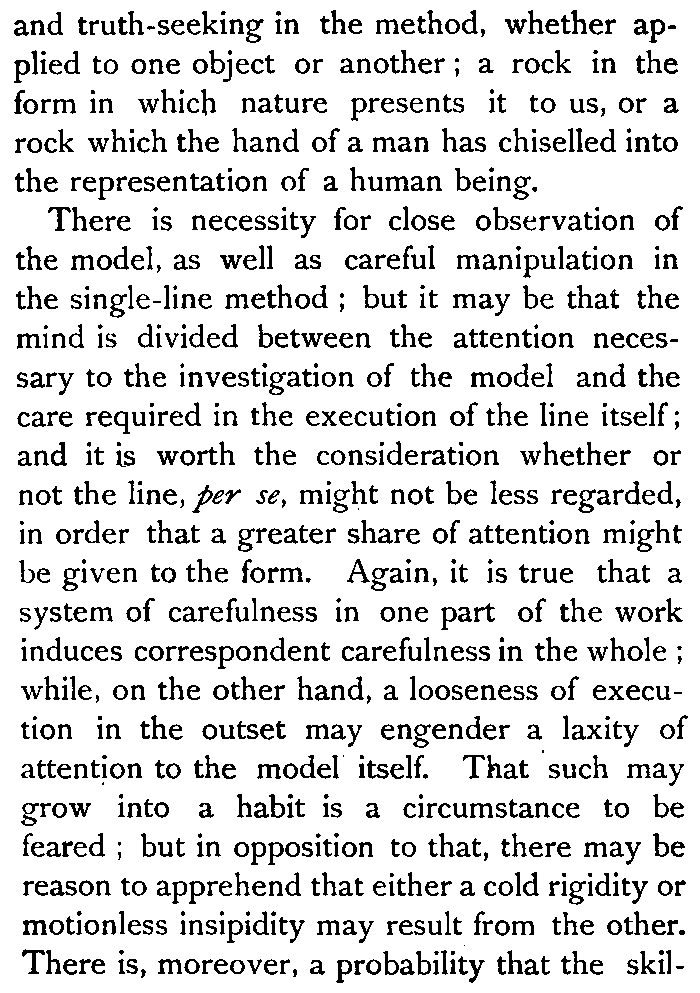
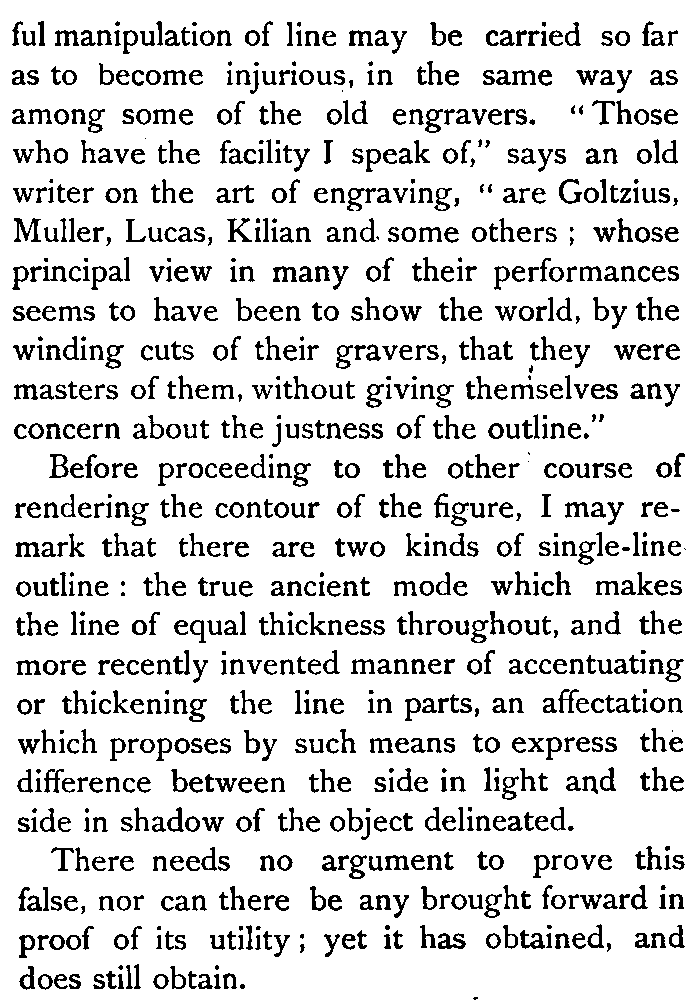
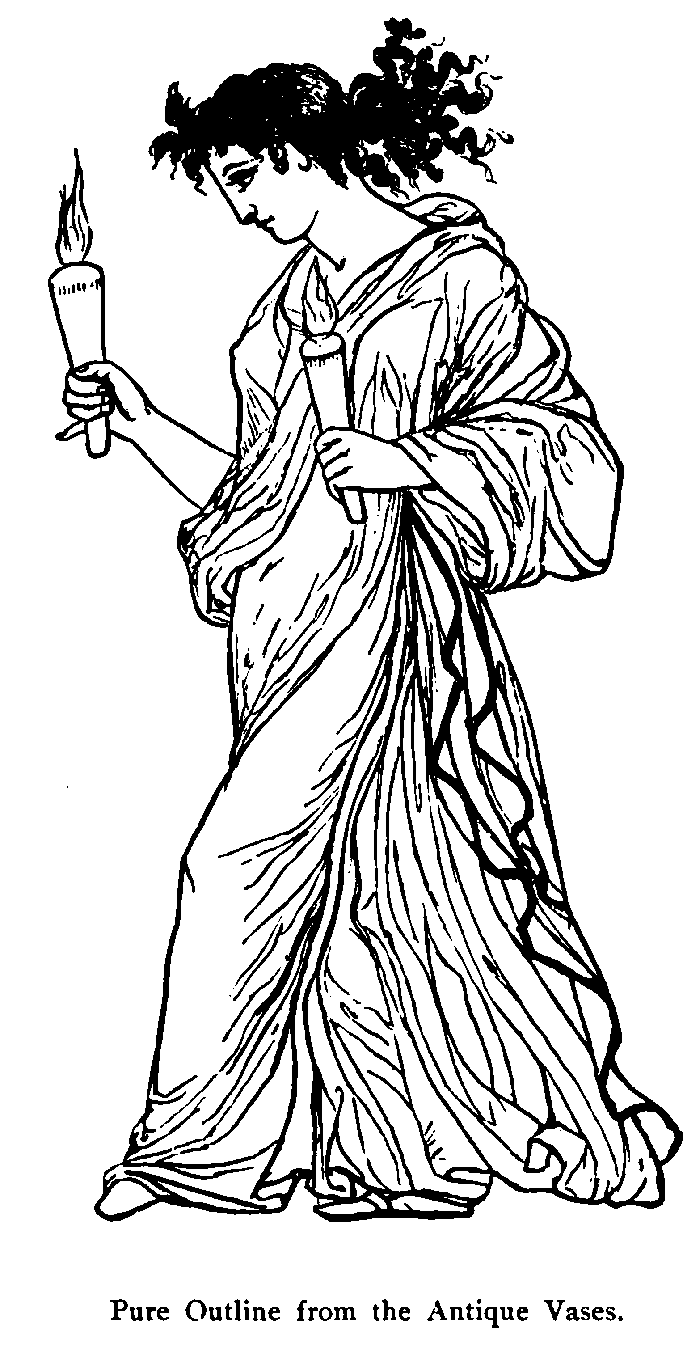
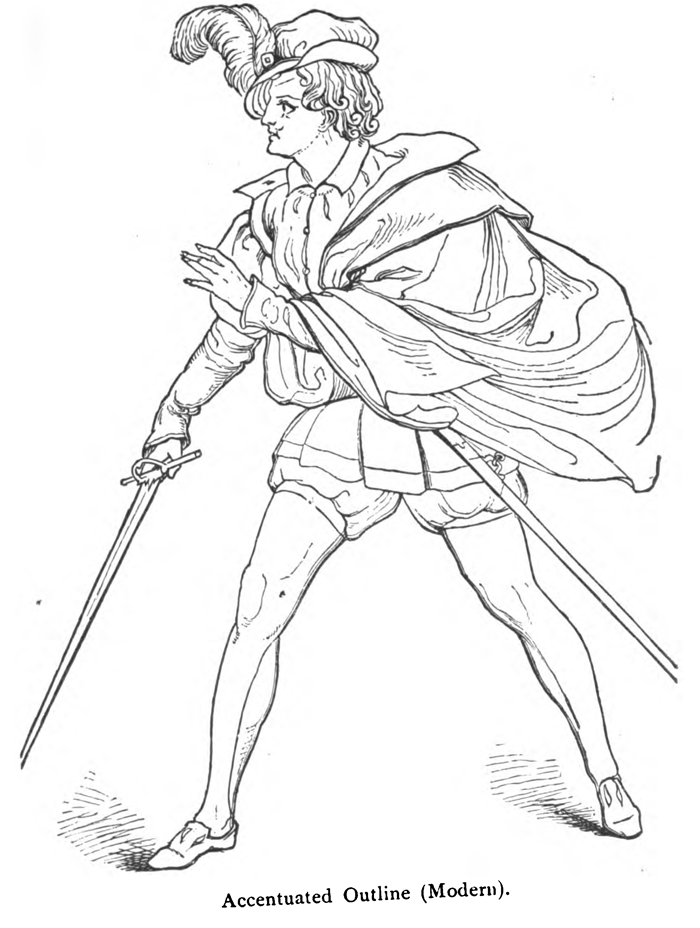


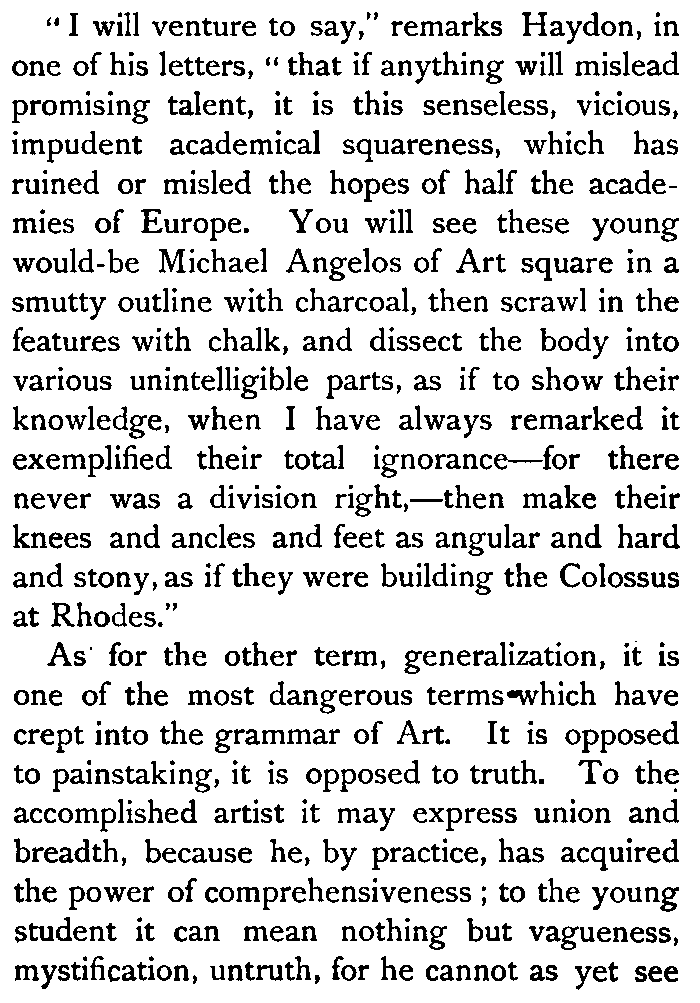
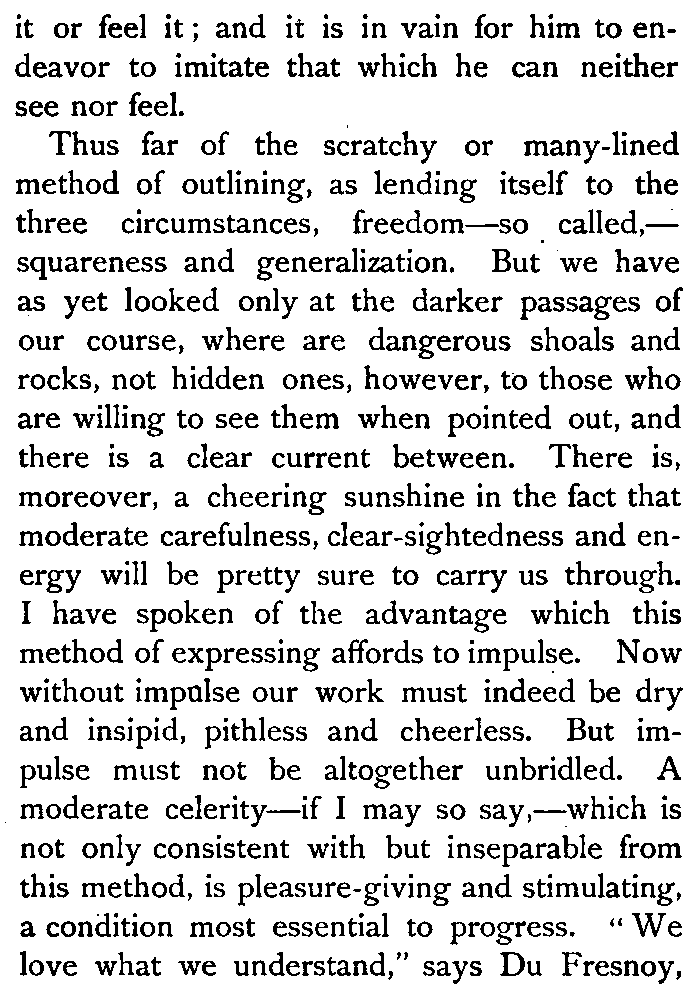


ON DIFFERENT KINDS OF LINE.
ON the kind of line to be adopted for the drawing—either with the black lead pencil or other material—of the human figure, much difference of opinion exists.
That a pure simple outline is beautiful cannot be doubted. The classical figures on the antique - pottery might be brought forward in proof. That they are for the most part beautiful is not denied, but neither can it be denied—beautiful as they are—that they are full of untruths, that they are conventional, and exhibit clearly the fact of their having been done without models. The rounded or globose forms of pottery call for certain modifications of drawing or contour, in order that the figures or objects depicted may present a symmetrical totality when viewed from a particular and suitable point. Not so the antique Greek statues, wherein is evidence
of careful and close study of the living human form immediately from nature. That the pure simple outline may be truthful, no one will gainsay, that is, as far as any line by which it is proposed to express the boundary of a form can be ; as far as any line can be, where in nature—which is sought to be represented—no outline exists.
In the very earliest paintings we know of—those of the old Egyptians—recourse was had to outline, whatever the subject ; outline purely being a single line executed firstly with a chalk or paint of one color and corrected with another color. Here we have at any rate precedent, and a most.ancient precedent too, for the pure simple outline.
Let us now consider another method of representing form, that is, by a number of loose scratchy lines laid together, leaving the spectator either to choose which he pleases, or take all together. It would seem at the first glance that this could not be the truth, but on reflection it will be found, at any rate, as near to it as the other ; and he who is sceptical on this point would do well to examine one of Correg
gio's pictures, and try to find, in the exquisite blending of object with object, the place of any single outline.
Ere more is said with reference either to the one or the other of these two methods, let us cite a third which, by the by, seems paradoxical inasmuch as, in this method, no outline of any sort is resorted to, the color being put on at once in patches and made to fit, like a child's puzzle map, according to spaces and quantities.* This would seem to be the true method, and so it would be, if it could be carried out ; but it cannot be carried out ; the human eye and the human judgment, it would appear, are incompetent to the task. The most skilful artist could not do it with any approach to certainty, much less could a tyro. True it is that the practised painter has the power of altering and uniting the tints in the progress of his work, whether as to color, or quantity, or space of surface covered ; but as he has also the power of hiding or obliterating outline at
his pleasure, he sees little reason for depriving himself of its aid. Let us now canvass the advantages and disadvantages of the two methods under _consideration—discarding the third as unnecessarily discouraging. The limner's art is sufficiently difficult in itself, and it needs not that we should deprive ourselves of any help which may be available in our pursuit of it.
Return we then to the single line, under the impression that all subjects if alike exact—strictly, honestly exact in the rendering—are equally difficult. It may be, as I have said before, a question as to how far an outline should be servilely exact in representing certain forms. The landscape painter, for instance, outlines his trees with general attention to masses only ; he draws his rocks and banks, for the most part, not less vaguely ; his architecture, in many cases, it is true, he treats differently ; but in no case does he confine himself to the fine equal line adopted by most figure draughtsmen. Yet there is no argument against such a course ; a bank or a shrub might as well be so rendered, were it the fashion to do so. There is evidence of painstaking
and truth-seeking in the method, whether applied to one object or another ; a rock in the form in which nature presents it to us, or a rock which the hand of a man has chiselled into the representation of a human being.
There is necessity for close observation of the model, as well as careful manipulation in the single-line method ; but it may be that the mind is divided between the attention necessary to the investigation of the model and the care required in the execution of the line itself ; and it is worth the consideration whether or not the line, per se, might not be less regarded, in order that a greater share of attention might be given to the form. Again, it is true that a system of carefulness in one part of the work induces correspondent carefulness in the whole ; while, on the other hand, a looseness of execution in the outset may engender a laxity of attention to the model itself. That such may grow into a habit is a circumstance to be feared ; but in opposition to that, there may be reason to apprehend that either a cold rigidity or motionless insipidity may result from the other. There is, moreover, a probability that the skil-
ful manipulation of line may be carried so far as to become injurious, in the same way as among some of the old engravers. " Those who have the facility I speak of," says an old writer on the art of engraving, " are Goltzius, Muller, Lucas, Kilian and some others ; whose principal view in many of their performances seems to have been to show the world, by the winding cuts of their gravers, that they were masters of them, without giving therriselves any concern about the justness of the outline."
Before proceeding to the other course of rendering the contour of the figure, I may remark that there are two kinds of single-line outline : the true ancient mode which makes the line of equal thickness throughout, and the more recently invented manner of accentuating or thickening the line in parts, an affectation which proposes by such means to express the difference between the side in light and the side in shadow of the object delineated.
There needs no argument to prove this false, nor can there be any brought forward in proof of its utility ; yet it has obtained, and does still obtain.
Pure Outline from the Antique Vases.
.
The other method of drawing form is, as I have said, that of a number of scratchy lines laid together. One object, a dangerous one, of this mode is, in the first place, the attainment of what is termed freedom ; in the next place, that which is common to this manner—indeed, almost inseparable from it—is squareness and generalization. I have already said that looseness is characteristic of it ; now it remains to be considered whether such looseness is an advantage or disadvantage in the carrying on of the work. I have said also that a certain carelessness may grow into a habit through it, which is to be put in the balance against other pernicious habits resulting from the single-line method.
We are in the habit of using the three terms, freedom, squareness, and generalization. Let us scrutinize our own ideas as to what we mean by these three terms. Firstly, then, what is freedom—freedom of hand ? If we are to understand it literally, I would say that the hand cannot be free from the thraldom of the mind. Insanity, drunkenness, imbecility are the three conditions in which may be found the nearest
approach to freedom of hand. Drawing would indeed be wild work, if done with such a free hand. If, on the other hand, we are not to take it literally, for what is it to stand ? If it is understood to mean freedom from trammels of obsolete Art rules, then I say it is good ; but then it is not freedom of thought. If it mean freedom from all rule, then I say it is bad. If, as a conventional term, it means celerity of execution, running hand in hand with the swiftness and readiness of thought, its value must be felt and admitted. But let the tyro beware of freedom so called.
Squareness, as a term, we can better understand. By its abstraction for the moment from the cold—but nevertheless meritorious, because careful—particularisation of the minor circumstances of form, it suffers no evaporation of impulse or of immediate impression. Squareness, as thus understood, should, I think, to a certain extent be held as good ; but certainly not that affectation of squareness, for squareness' sake, and for the sake of nothing else, which has obtained to a fearful extent among students of the figure.
" I will venture to say," remarks Haydon, in one of his letters, " that if anything will mislead promising talent, it is this senseless, vicious, impudent academical squareness, which has ruined or misled the hopes of half the academies of Europe. You will see these young would-be Michael Angelos of Art square in a smutty outline with charcoal, then scrawl in the features with chalk, and dissect the body into various unintelligible parts, as if to show their knowledge, when I have always remarked it exemplified their total ignorance—for there never was a division right,—then make their knees and ancles and feet as angular and hard and stony, as if they were building the Colossus at Rhodes."
As• for the other term, generalization, it is one of the most dangerous terms-which have crept into the grammar of Art. It is opposed to painstaking, it is opposed to truth. To the accomplished artist it may express union and breadth, because he, by practice, has acquired the power of comprehensiveness ; to the young student it can mean nothing but vagueness, mystification, untruth, for he cannot as yet see
it or feel it ; and it is in vain for him to endeavor to imitate that which he can neither see nor feel.
Thus far of the scratchy or many-lined method of outlining, as lending itself to the three circumstances, freedom—so called,— squareness and generalization. But we have as yet looked only at the darker passages of our course, where are dangerous shoals and rocks, not hidden ones, however, to those who are willing to see them when pointed out, and there is a clear current between. There is, moreover, a cheering sunshine in the fact that moderate carefulness, clear-sightedness and energy will be pretty sure to carry us through. I have spoken of the advantage which this method of expressing affords to impulse. Now without impulse our work must indeed be dry and insipid, pithless and cheerless. But impulse must not be altogether unbridled. A moderate celerity—if I may so say,—which is not only consistent with but inseparable from this method, is pleasure-giving and stimulating, a condition most essential to progress. " We love what we understand," says Du Fresnoy,
Fac-simile of a drawing by Raffaelle.
" we desire what we love, we pursue the enjoyment of those things which we desire, and arrive at last at the possession of what we have pursued, if we warmly persist in our design."
I have placed before the reader—I hope impartially—the advantages and disadvantages of the two methods of delineating contour. The student will make his own election, or, what is better, will practise both the methods as did the great masters before him.
|


















